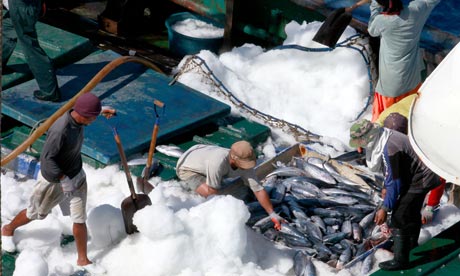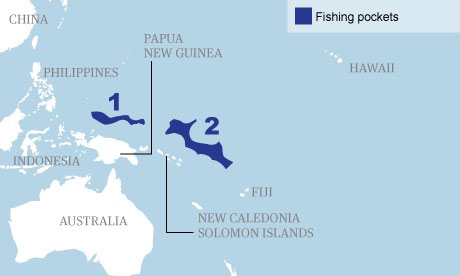
Frozen tuna catch. (Photo Credit: Terje Engoe/Copyright: FIS)
 WORLDWIDE
WORLDWIDETuesday, July 29, 2014, 22:50 (GMT + 9)
A new report on the state of the world’s main commercial tuna stocks released by the Sustainable Fisheries Partnership (SFP) identifies opportunities for improvement in the status of the resource and in regional management systems for tuna fisheries.
The report, Sustainability of Main Commercial Tuna Stocks, evaluated 22 stocks of major commercial tuna species based on available public data and criteria from SFP’s FishSource.com programme.
Based on an assessment against the FishSource criteria on governance and stock status, none of the 22 tuna stocks were both very well managed and in very good conservation status, meaning that all of the stocks are in need of some improvement. Half of the stocks were adequately managed and with acceptable conservation status, while the other half were poorly managed and/or with poor conservation status.
Further highlights of the report include:
- Increasing demand, overcapacity, poor compliance with existing management measures, and rudimentary governance systems call into question the long-term sustainability of some tuna fisheries.
- Eastern Pacific Ocean skipjack and yellowfin tuna stocks have been fully exploited while eastern Atlantic Ocean skipjack, western Atlantic Ocean skipjack, western and central Pacific Ocean skipjack, and western and central Pacific Ocean yellowfin have been moderately exploited.
- Five tuna stocks (Atlantic Ocean bigeye, east Atlantic Ocean and Mediterranean bluefin, north Atlantic Ocean albacore, south Atlantic albacore, Indian Ocean yellowfin) have had long-term declining trends in biomass but with signs of recent improvements. The report notes these as “climbers.”
- Four stocks (Indian Ocean bigeye and albacore, west Atlantic Ocean bluefin, Atlantic Ocean yellowfin) have had long-term declining temporal trends in biomass. The report notes these as “fallers.”
- Future changes in the status of these stocks of “climbers” and “fallers” should be monitored closely to determine if the current management system successfully maintains the stocks at levels consistent with precautionary management targets.
- Of 95 fisheries that supply tuna products to North American, European, Australian, and other markets, 28 (30 per cent) were either certified or under full assessment against the Marine Stewardship Council (MSC) standard or are in a fishery improvement project (FIP).
Given that all of these 95 fisheries supply tuna from stocks requiring improvements in management and fishing practices, the 70 per cent that are neither in the MSC programme nor in a FIP require attention: companies in the supply chains for these fisheries and other stakeholders are encouraged to establish appropriate FIPs to incentivize positive changes toward sustainability to a point where the fisheries would unconditionally pass an assessment against the MSC standard or equivalent.
Jim Cannon, CEO of SFP, noted, “The demand for tuna is always high but our report shows how fisheries are performing against the sustainability standards of the retail industry and there is a serious shortfall in tuna supplies that are managed sustainably. We encourage fisheries and suppliers in these tuna supply chains to establish and implement FIPs. Positive changes in management practices will help close the gap.”

